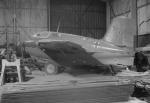
Concise history from Phil Butler's 'War Prizes':
AM207 Messerschmitt Me 163B WNr 191614
Aircraft of JG 400. Surrendered at Husum and shipped to the RAE. Despatched from Farnborough to No. 6 MU, Brize Norton, on 21st July 1945. No further record. This may conceivably, be the aircraft (reputedly; WNr1916-14') which was for many, years at the Rocket Propulsion Establishment at Westcott and which in 1980 was transferred to the Aerospace Museum at RAF Cosford and is currently there as '191614' (8481 M).
A unique photo turned up in 2006, showing the Cosford Komet at the Rocket Propulsion Establishment in Westcott. Although it shows no identity, the missing 'skid bay' panels and wing root fairings clearly show that this is indeed the same Komet. 191614 arrived here from No.6 MU (Brize Norton) at an unknown date, and left for the (then) Aerospace Museum at RAF Cosford, now named RAF Museum Cosford.
It appears to have been repainted, with the possible exception of the canopy. Care has been taken to maintain the original German stencils visible by painting around them, see for example the rear lower fuselage. The underwing cross can also been seen, and interestingly it is applied along the longitudinal axis of the aircraft.

Former RAF Sergeant Tom Avery reported this valuable piece of history of the Cosford Komet. He witnessed a repaint (likely that seen above) from up close, as he was very interested in the aircraft, while working on a different exhibit:
The RAF Cosford Komet was at RAF Cottesmore in the late sixties for a Battle of Britain open day. A Flight Lieutenant who was overseeing the preparations decided it would look much better if it were to be repainted. The painters and dopers discussed colours and told him that they had no paint that matched the original colours. They were told to 'knock something up' and paint it quickly as time was getting short. Some time later the Flt/Lt came running over shouting "Stop painting that aircraft!" Cosford has said it must not be painted or have the appearance changed in any way. By this time the painter had painted half the airframe and was asked to clean it off, which he could not do. So it was decided to finish the spraying. After the respray it had unfortunately lost a lot of impact from the original German colours.
Note: at this point in time the Cosford Komet appears to be still the property of the Rocket Propulsion Establishment at Westcott. In the 'report' shown below, the first repaint is also listed as the third item under the 'History' heading, but without any details.
Gert Jan van Laar (The Netherlands) made the photo below in October 1982. The camouflage appears to be a hard-edged solid camouflage in olive drab and light grey, overpainted with random medium grey mottles. The effect is not bad, but no German Komet was ever painted this way. Interesting details are the blistering paint on the steel nose cone revealing red oxide primer (or maybe rusting steel?), the replacement (dummy) upper wing root panel / gun bay cover painted matt green, and a red rudder lock has been fitted.
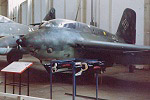
|
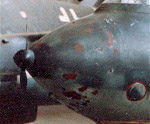
|

|
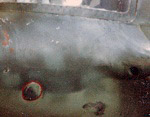
|
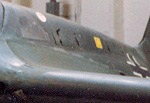
|
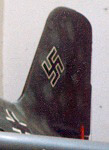
|

|
Shamus Reddin made a single detail photo around 1990. It appears to show the same camouflage as shown above: a hard-edged solid camouflage in green(s) and light grey, overpainted with medium grey mottles.

The following photo from June 1989 seems slightly older, since it shows a repainted rear fuselage without mottling. The original photo shows a line-up of the museum's Ki 100-Ib, Fi 156C, Me 262A, Me 163B and Fi 103.

The following two photographs were supplied by Ludo Kloek. They show the aircraft's strange colors of black and green. It carries only standard Luftwaffe markings and no individual markings. The Werknummer (191614 if it is correct) is not painted on.


Terence Lynock, former Cosford research librarian, reported the following details about the aircraft:
the cockpit I remember was painted all black inside and the seat was missing. Rudder and elevators were still connected
the generator in the nose still worked. We spun it up with a hand held starter someone made (read just a bloody big Black and Decker drill with a chopped off starter dog in the chuck) and it produced about 24 Volts.
although they belonged to the Me 262 at Cosford we did have a set of four Rheinmetal Borsig 30mm cannon identical to the Me 163 cannon, apart from they were shorter barrels in the 262. I think they are on display now. I remember them because I had the job of moving them more than once and were they bloody heavy or what! How a 262 got off the deck with four of them in the front end I don't know.
The following report was compiled by Shamus Reddin. The photos concluding the report are also by Shamus Reddin.
Exhibited on public display, (12th February 1999) in Hangar No.3, between the hangar wall and under the wing of Me 262, and behind the Me 410.
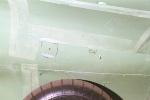
The airframe is largely complete, although upper wing root panels on both sides are missing, and have been replaced by hardboard dummies. It is also likely that both underside panels are not original. Wing root panel edges on the upper and lower surfaces are held with wide bands of doped fabric, extending from the nose along to the tail, and across the forward and rear edges of the panels. The airframe has an engine fitted - this was not available for inspection. No cannon are installed. Two Mk.108 cannon are displayed on a stand alongside the airframe, and although it cannot yet be accurately ascertained if they were originally from the Komet, they do have painted reference codes which indicate they belong with the Komet.
The paintwork is of poor quality and in several places has cracked and worn very thin. The starboard upper wing surface clearly shows the grain of the wing construction through the thin paint. There are a number of patches where the paint is worn down to the bare wood. The colour scheme is abstract and does not appear to follow any standard scheme for the type. One assumes the painting was done by personnel who did no research, painting in "generic" Luftwaffe colours - dark green with sprayed patches of black-green on the upper fuselage and wings. The under surface more closely matches RAF duck egg green/blue. The repaint has been done over the doped fabric. The drawings shown below show the camouflage scheme (click for larger size). The colours are only an approximation, using Windows 95's 256 colour palette.
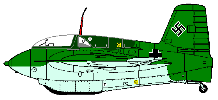
|
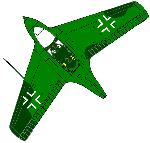
|
The cockpit is a curious mixture of original instruments in un-restored settings and others that have been refixed into repainted panels, or that have had markings re-painted on them. The central instrument console is freshly painted in a light grey, with the instruments neatly positioned. The side panels however, seem more dust covered and more untouched. The cockpit seat is missing, but the rest of the cockpit appears complete. An attempt has been made at restoration at some point in the aircraft's history, but not apparently at Cosford. Apart from the original hinged ventilation window, a square has been cut out of the plexiglass of the port rear side of the cockpit canopy. The cockpit canopy is fixed shut with a brass padlock and hasp - quite out of keeping with the airframe.
The airframe is displayed alongside a Walter 109-509C dual chambered engine. This engine carries no makers plate at any point on the engine, frame or bearers. However, the layout leads me to suspect that it is a 109-509C and not a dual chambered B model. The engine is well preserved, but has been painted in very bright, non-standard (to my knowledge) colours of silver, bright blue, red, yellow and black, presumably as an attempt at colour-coding the individual systems. No legend or diagram is displayed to explain the painting. The standard of painting is not high and individual parts have patches without paint and the paint has run in a number of places. Several parts have makers manufacturing codes and stamps which could identify the engine parts, although these are too numerous to mention. Painted on the main combustion chamber fairing is the accession number 1987/0243/E F1526.
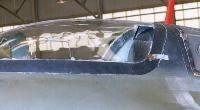
|
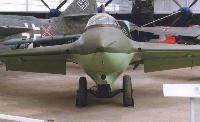
|
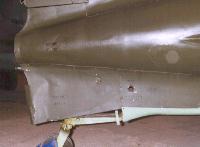
|

|
In April and June 2000 I received two sets of great photographs that were kindly provided by Graham Causer, by way of David McDonald and Richard T. Eger, Me 262 historian and researcher. They show a very thorough disassembly of the Cosford Komet, apparently for a restoration. Details of this restoration (such as duration and level of restoration work) are currently lacking. Note that the phots were made on two occassions, and therefore sometimes show different states of disassembly. Anyway, Graham Causer's photographs show incredible detail, many never seen before. Enjoy!

Another extensive set of photographs of this restoration were kindly supplied by Douglas Downer-Smith. He too visited the Cosford museum in April 2000. Douglas' photos show many components in great detail. I currently lack the time to add captions, unfortunately.
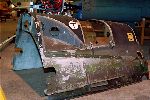
More photos of the Cosford restoration from September 2000 can be found on Andre de Zwart's excellent Dornier Do 24 website, under 'museum visits', and Glijn Van Driessche's Aircraft walkarounds site has 142 restoration photos that he made in October 2000 in Part 1 and Part 2.
Michael O'Sullivan wrote that Flypast magazine had a report on the restoration in its July 2002 issue. Flypast reports:
Messerschmitt Me 163B Komet 191614 has been under restoration by a team of Cosford volunteers for around two years and is rapidly approaching completion. After strip-down and inspection of the rocket-powered interceptor's fuselage, the team found very little corrosion, with major areas only in need of cleaning. The powerplant has been disassembled, assessed, cleaned and then put back together. The wooden wings have been sanded down and found to be in first class condition. The only major component missing was the pilot's seat. Fortunately, the Imperial War Museum's Duxford based Komet has one fitted and this has been used as a pattern for a reconstruction at Cosford. The team's next task will be to fit the wings and then hand the project over to the RAF Museum's restoration team, which will construct wing root panels, replacing the poorly fitting non-original units previously in place. After this and some similar metal panel work, it will move into the spray shop for repainting. It is hoped that work will be completed in late 2002 or early 2003.
Terry Gray sent the following photo report that he made in April 2005. He reported that the refurbishment was nearing completion: the fuselage and wings have been reassembled and resprayed, but the wings still have to be attached to the fuselage. A number of wing root panels still need to be made, and likely some panels of the skid fairing too. The camouflage scheme is RLM 70/71/65.
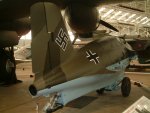
|

|
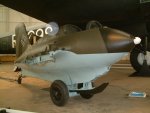
|
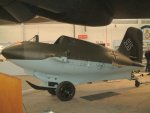
|
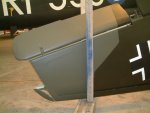
|
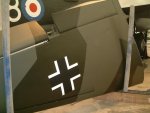
|
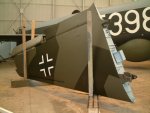
|
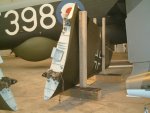
|

|
Kevin Blacktop visited Cosford in August 2009 and noted that the Komet was repainted again. Unfortunately the zebra type camouflage is not typical for a Komet. Werknummer 191461 and a yellow code 14 have been applied.
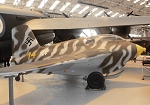
|
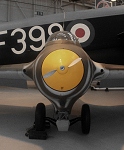
|
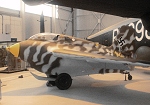
|
Terry Gray visited Cosford again in October 2009 and kindly provided a few more photos of the new camouflage.
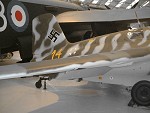
|
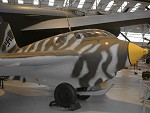
|
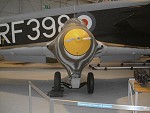
|
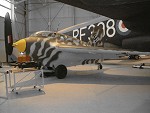
|
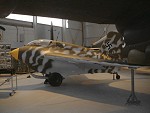
|
In 2009, the restoration team gave the Komet its third camouflage after the restoration, this time in sort-of mottle scheme. The aircraft went back on display in July 2009. It's better but still not a good representation of a Komet camouflage. David McDonald kindly sent the photo below to show the new paint job.

|
Kevin Blacktop visited Cosford in 2017, during an 'open cockpit' event, and shot a great set of interior photos. He remembers that probably the only part missing before the restoration was the seat, but one of the restoration team said that they had visited the Duxford Komet, while that was being part restored before sale, and they copied the seat.
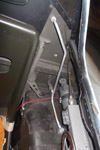
|
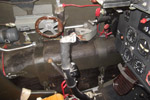
|
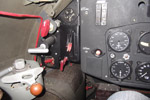
|
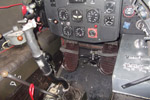
|
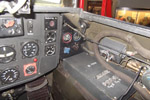
|
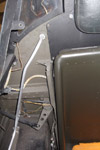
|
Kevin Blacktop visited Cosford again in 2018, and made some overall and detail shots. The close up of the skid seems to show that the top surface of the skid was laminated with wood or resin. This had always been present, Kevin had noticed this before the restoration was started in 2000.
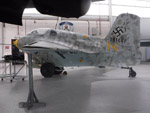
|
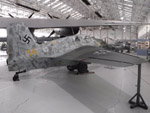
|
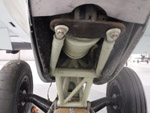
|
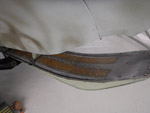
|
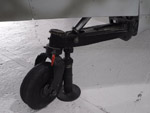
|
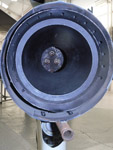
|
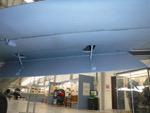
|
Kevin Blacktop visited Cosford one more time in July 2020, and provided two photos.

|
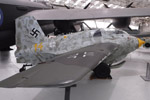
|
Although I'm happy to see this Komet in a much better condition than before, I'm not very happy with the end result either. I'm a bit reluctant to criticise the restoration since it was done with a lot of care, but I think I need to be honest in my comments.
Firstly the about the first two paint schemes and paint colours. Let me start by stating that I've studied Komet camouflage for years now, and still don't have the definitive answers. But I cannot find a single photo that shows the splinter scheme applied to this Komet. The only hard-edged splinter camo Komet with a 'solid' painted tail is 'White 13' which is only very vaguely visible in this photo. White 11 also had a 'solid' painted tail, but the camouflage wasn't hard-edged. A hard edge between the upper and lower camouflage is something I have never seen on a Komet. The color choice is also debatable for a late-production aircraft. The only Komet of which the original colors are known is the Australian 191907, and it was painted in RLM 81/82/76. 191614 was built a little earlier by the same manufacturer (Junkers/Baugruppe A), so I believe the chances of it having the same colors are high. Lastly, the swastika appears too big to me. The 'zebra' camouflage that was applied next was equally unrealistic. The third camouflage is a lot better, but still not a mottle camouflage as applied to wartime Komets; instead of spots it has swirls and stripes.
Secondly the appearance of the aircraft. I think it has been over-restored. All the 'life' is gone from the aircraft. Everything is smooth and tidy and perfect like a modern airliner, and nothing remains of a rapidly-built war machine. Adding to this is the completely monochrome paint, with not a speck of dirt in it. Once assembled it will look like a giant RC-model. I wish museums would start thinking about deliberately weathering their exhibits.. I repeat what I wrote on the Ottawa 191914 page: "After seeing the restoration work done on the NASM Arado 234, a German Ar 234 pilot remarked that if his plane would have looked so nice, the English troops would have thrown flowers at his aircraft instead of shooting at it."
I was very happy to find that at least some museums are more careful with preserving history: take a look at the Fleet Air Arm Museum's Corsair KD 431 page. There is hope!
The Komet was moved to the RAF Museum in Hendon, and was first seen there in April 2022. Seven hi-res photos can be seen in a photo report on Philip Stevens' Target Aviation Photography website.